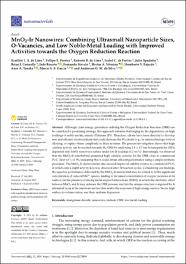Mostrar el registro sencillo del ítem
MnO2-Ir Nanowires: Combining Ultrasmall Nanoparticle Sizes, O-Vacancies, and Low Noble-Metal Loading with Improved Activities towards the Oxygen Reduction Reaction
| dc.contributor.author | de Lima, Scarllett L. S. | es_ES |
| dc.contributor.author | Pereira, Fellipe S. | es_ES |
| dc.contributor.author | de Lima , Roberto B. | es_ES |
| dc.contributor.author | de Freitas, Isabel C. | es_ES |
| dc.contributor.author | Spadotto, Julio | es_ES |
| dc.contributor.author | Tanaka, Auro A. | es_ES |
| dc.contributor.author | Garcia, Marco A. S. | es_ES |
| dc.contributor.author | da Silva, Anderson G. M. | es_ES |
| dc.date.accessioned | 2022-11-24T20:19:45Z | |
| dc.date.available | 2022-11-24T20:19:45Z | |
| dc.date.issued | 2022-09-01 | |
| dc.identifier.uri | https://hdl.handle.net/20.500.13053/7233 | |
| dc.description.abstract | “Although clean energy generation utilizing the Oxygen Reduction Reaction (ORR) can be considered a promising strategy, this approach remains challenging by the dependence on high loadings of noble metals, mainly Platinum (Pt). Therefore, efforts have been directed to develop new and efficient electrocatalysts that could decrease the Pt content (e.g., by nanotechnology tools or alloying) or replace them completely in these systems. The present investigation shows that high catalytic activity can be reached towards the ORR by employing 1.8 ± 0.7 nm Ir nanoparticles (NPs) deposited onto MnO2 nanowires surface under low Ir loadings (1.2 wt.%). Interestingly, we observed that the MnO2 -Ir nanohybrid presented high catalytic activity for the ORR close to commercial Pt/C (20.0 wt.% of Pt), indicating that it could obtain efficient performance using a simple synthetic procedure. The MnO2 -Ir electrocatalyst also showed improved stability relative to commercial Pt/C, in which only a slight activity loss was observed after 50 reaction cycles. Considering our findings, the superior performance delivered by the MnO2 -Ir nanohybrid may be related to (i) the significant concentration of reduced Mn3+ species, leading to increased concentration of oxygen vacancies at its surface; (ii) the presence of strong metal-support interactions (SMSI), in which the electronic effect between MnOx and Ir may enhance the ORR process; and (iii) the unique structure comprised by Ir ultrasmall sizes at the nanowire surface that enable the exposure of high energy surface/facets, high surface-to-volume ratios, and their uniform dispersion.“ | es_ES |
| dc.format | application/pdf | es_ES |
| dc.language.iso | eng | es_ES |
| dc.publisher | MDPI | es_ES |
| dc.rights | info:eu-repo/semantics/openAccess | es_ES |
| dc.rights.uri | https://creativecommons.org/licenses/by/4.0/ | es_ES |
| dc.subject | manganese dioxide; nanowires; iridium; ORR; low metal loading | es_ES |
| dc.title | MnO2-Ir Nanowires: Combining Ultrasmall Nanoparticle Sizes, O-Vacancies, and Low Noble-Metal Loading with Improved Activities towards the Oxygen Reduction Reaction | es_ES |
| dc.type | info:eu-repo/semantics/article | es_ES |
| dc.identifier.doi | https://doi.org/10.3390/nano12173039 | es_ES |
| dc.type.version | info:eu-repo/semantics/publishedVersion | es_ES |
| dc.publisher.country | CH | es_ES |
| dc.subject.ocde | http://purl.org/pe-repo/ocde/ford#5.08.02 | es_ES |
Ficheros en el ítem
Este ítem aparece en la(s) siguiente(s) colección(es)
-
SCOPUS [380]


